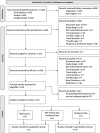Incidence and risk factors for travellers' diarrhoea among short-term international adult travellers from high-income countries: a systematic review with meta-analysis of cohort studies
- PMID: 38224319
- PMCID: PMC11896841
- DOI: 10.1093/jtm/taae008
Incidence and risk factors for travellers' diarrhoea among short-term international adult travellers from high-income countries: a systematic review with meta-analysis of cohort studies
Abstract
Introduction: Travellers' diarrhoea (TD) continues to be the most common travel-related medical event in international travellers. Updated incidence and risk factor data will improve pre-travel medical advice for travellers from high-income countries (HICs), providing an opportunity for disease prevention and appropriate disease management.
Methods: A systematic search for cohort studies of TD incidence published between 1 January 1997 and 2 March 2023 was performed using Ovid Medline, SCOPUS and Google Scholar databases. Study quality was assessed with a modified Newcastle-Ottawa Scale (NOS). We extracted incidence data for adults travelling less than 100 days from HIC and available risk factor data. The overall random-effects pooled incidence and the corresponding 95% confidence intervals (95% CI) were estimated. Heterogeneity was assessed using the I2 statistic, tau and the 95% prediction intervals. Subgroup analyses were conducted to identify the sources of heterogeneity. Risk factor studies were reviewed qualitatively and described.
Results: Ten studies were included in the meta-analysis, containing 8478 participants. Two of the studies measured as high quality and eight as good quality as assessed by the modified NOS. The TD incidence was 36.1% (95% CI 24-41%; I2 94%), with a prediction interval ranging from 20.3 to 55.8%. The pooled incidence of mild, moderate and severe TD was 23.6, 8.1 and 2.9%, respectively. Subgroup analysis showed that the incidence increased with increasing average data collection period. Risk factors for TD in travellers from HIC identified include younger age, longer travel periods, low and middle-income destinations, travelling for tourism, backpacking travel styles and pre-travel health status.
Conclusion: It is estimated that between 20 and 56% of international travellers can expect to develop TD in travel of under 100 days. While most cases are mild, ~3% of all travellers will experience a disease that prevents usual activities or requires medical attention.
Keywords: Travel diarrhoea definition; epidemiology; gastrointestinal symptoms; modified Newcastle-Ottawa Scale; pre-travel counselling; tourism.
© International Society of Travel Medicine 2024. Published by Oxford University Press.
Figures




References
-
- Steffen R, Hill DR, DuPont HL. Traveler's diarrhea: a clinical review. JAMA 2015; 313:71–80. - PubMed
-
- Adler A, Ciccotti H, Trivitt S, Watson RCJ, Riddle MS. What's new in travellers' diarrhoea: updates on epidemiology, diagnostics, treatment and long-term consequences. J Travel Med 2022; 29:1–10. - PubMed
-
- Lääveri T, Pakkanen S, Kirveskari J, Kantele K. Travellers' diarrhoea: impact of TD definition and control group design on study results. Travel Med Infect Dis 2018; 24:37–43. - PubMed
-
- Connor B. Travelers' Diarrhea. New York, USA: Oxford University Press, 2024. [updated 01 May 2023. Travelers’ Health]. https://wwwnc.cdc.gov/travel/yellowbook/2024/preparing/travelers-diarrhea (23 November 2023, date last accessed).
Publication types
MeSH terms
LinkOut - more resources
Full Text Sources
Medical

